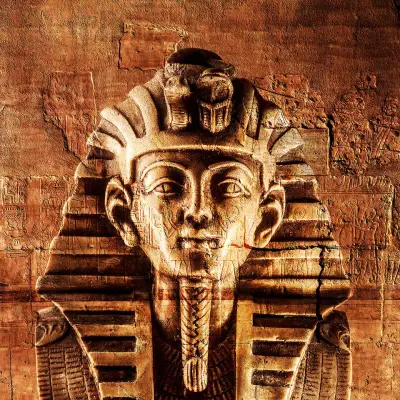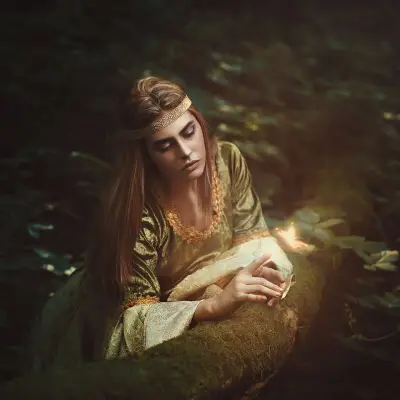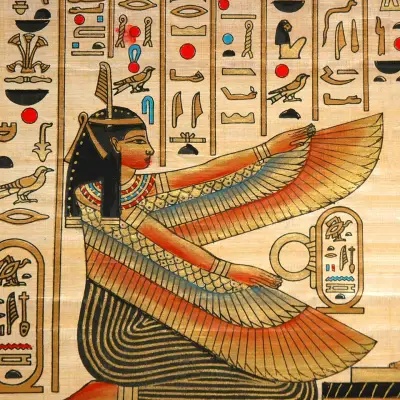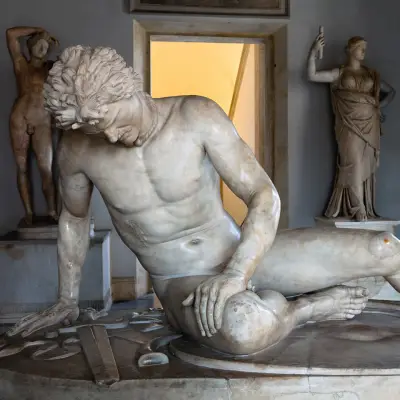Brigid is both a goddess and a celebrated saint in Celtic Mythology. With powers spanning fire, healing, and poetry, she holds a unique place as a triple goddess, embodying inspiration, protection, and transformation.
This blog post explores the myths, powers, and symbols associated with Brigid, uncovering why she remains such a compelling figure today.
Jump to:
- Who Was Brigid in Celtic Mythology?
- Brigid's Myths
- The Role of Brigid in Celtic Storytelling
- What Powers Did Brigid Possess?
- Symbols Associated with Brigid
- Brigid's Lineage and Connections
- Why Is Brigid Special?
- Brigid in Modern Culture
- Brigid’s Worship and Legacy
- Frequently Asked Questions About Brigid
- Study Celtic Mythology for £29
Recommended for you!
Best SellersWho Was Brigid in Celtic Mythology?
Brigid is one of the most famous figures in Celtic mythology, known as the Celtic goddess of fire, healing, and poetry. She is often referred to as the “Exalted One” and is considered a powerful and multifaceted deity associated with the land, fertility, and the sacred flame.
In Irish mythology, Brigid is the daughter of the Dagda, one of the chief gods of the Tuatha Dé Danann. Her influence was so powerful that she was later syncretised with Saint Brigid of Ireland, a significant Christian saint. Brigid is also regarded as a triple goddess, embodying the three aspects of inspiration, healing, and smithcraft. This trinity highlights her role as a goddess of both physical and spiritual nourishment, making her a unique and enduring figure in Celtic culture.
Brigid's Myths
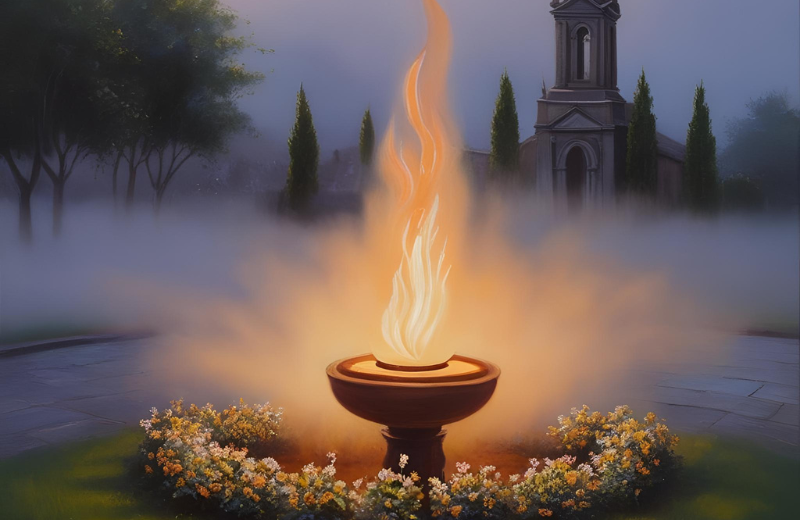
From her connection to the sacred flame to her role as a protector and healer, Brigid’s myths have cemented her place as a powerful and enduring figure in Celtic mythology.
The Origin of Imbolc
One of the most well-known tales involving Brigid is her connection to the festival of Imbolc, celebrated on the 1st of February. Imbolc, meaning “in the belly,” symbolises the midpoint between winter and spring and is a time of purification and renewal.
In the myth, Brigid is said to have blessed the land with fertility and warmth, encouraging the first signs of spring to emerge. She was also credited with bringing the art of keening to the world, a mournful lament sung to honour the dead, after the loss of her own son in battle.
The Eternal Flame of Kildare
Another prominent myth involves Brigid’s eternal flame, a symbol of her power as the goddess of fire. The flame was said to have been tended by nineteen priestesses or nuns at Kildare, each taking a turn to guard and maintain the sacred fire.
On the twentieth day, it was believed that Brigid herself would tend the flame. The flame symbolises her connection to fire and her transformative and protective nature. The tradition continues today, with the flame still burning as a tribute to her enduring legacy.
Brigid and the Healing Waters
Brigid was also closely associated with healing wells and springs, believed to hold her restorative powers. According to one tale, Brigid blessed a sacred well with healing properties, transforming it into a place where people could seek comfort and recovery from ailments.
This well became a site of pilgrimage, with devotees offering coins and other tokens in exchange for her blessings. The waters were said to be particularly potent on Imbolc, further emphasising Brigid’s role as a healer and protector of the land and its people.
The Role of Brigid in Celtic Storytelling

Brigid is a symbol of the interconnectedness of nature, the elements, and human life. Her stories often emphasise themes of healing, creativity, and the cyclical nature of life.
The goddess is also depicted as a fierce protector and a nurturer, bridging the gap between the mortal and the divine. She appears in numerous stories as a wise woman, a healer, and a source of inspiration for poets and artists. Her presence in folklore highlights her significance as a deity who could traverse different realms, from the earthly to the spiritual, making her a bridge between worlds.
What Powers Did Brigid Possess?
Each aspect of Brigid’s power reflects a different facet of her identity as a goddess, emphasising her role as a protector, creator, and spiritual guide:
- Fire and Transformation: Brigid is closely associated with fire, symbolising transformation, purification, and renewal. As a goddess of the hearth and the forge, she oversees the act of smithcraft, where raw materials are transformed into tools and weapons. This fiery aspect also connects her to the sun, representing warmth, light, and life.
- Healing and Protection: Brigid’s healing powers are particularly potent in matters of childbirth, physical ailments, and emotional wounds. Sacred wells and springs were considered to hold her curative properties, attracting those seeking comfort and recovery. Offerings were often made at these sites in exchange for her healing blessings.
- Poetry and Inspiration: As a goddess of poetry, Brigid was believed to ignite creativity, eloquence, and inspiration. She was the patroness of poets and bards, inspiring them to convey powerful messages and stories. This power also extended to prophecy and divination, as her words were thought to carry divine insight and guidance.
Symbols Associated with Brigid

Brigid is associated with several Celtic symbols that reflect her diverse aspects:
- Brigid’s Cross: Made from rushes or reeds, this woven cross is a protective symbol, particularly associated with Imbolc. It’s often hung in homes to invoke her blessings and ward off evil.
- The Sacred Flame: Representing her fiery nature, the eternal flame in Kildare symbolises Brigid’s transformative power.
- Sacred Wells and Springs: These water sources symbolise her healing powers, with many still visited by those seeking her blessings.
- Animals: The swan, cow, and snake are all sacred to Brigid, representing transformation, nourishment, and renewal, respectively.
- Colours: Brigid is associated with white, symbolising purity, and red, representing fire and vitality.
Brigid's Lineage and Connections
Brigid’s origins are deeply rooted in Irish mythology, where she is portrayed as the daughter of the Dagda, one of the chief gods of the Tuatha Dé Danann. This connection places her firmly among the ranks of the powerful deities who governed the mystical Otherworld, bridging the gap between the mortal realm and the divine. The Dagda, often referred to as the “Good God,” symbolises abundance, strength, and wisdom, qualities that Brigid also embodies.
Brigid is sometimes described as having two sisters, also named Brigid, representing different aspects of her power – poetry, healing, and smithcraft. This triple aspect highlights her role as a multifaceted goddess who could shift between identities, serving as a healer, protector, and muse. Her lineage also connects her to the earth and nature, highlighting her role as a goddess of fertility, transformation, and the sacred flame.
Despite her pagan roots, Brigid was later Christianised as Saint Brigid of Ireland, further expanding her connections to include the Christian saints and monastic traditions. This transition allowed her to maintain her influence across both pagan and Christian contexts, reinforcing her enduring legacy as a bridge between worlds.
Why Is Brigid Special?
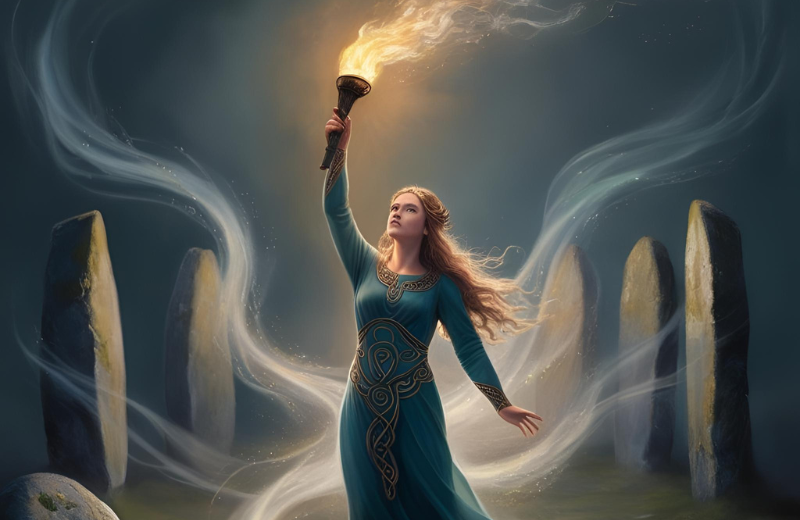
Brigid holds a unique position in Celtic mythology, not through acts of war or conquest, but through her embodiment of healing, creativity, and transformation. As a goddess of fire, she brings warmth, light, and renewal to the land and its people. Her presence is felt in the hearth’s flame, the forge’s fire, and the rising sun, representing the cyclical nature of life and the promise of rebirth.
Unlike gods associated with violence or dominance, Brigid’s power lies in her nurturing and protective nature. She is a patroness of poets and artisans, a healer of physical and emotional wounds, and a guardian of the home and family. Her myths encourage compassion, creativity, and the recognition of the sacred in everyday life.
Brigid in Modern Culture
Despite her ancient roots, Brigid remains a prominent figure in modern spiritual and cultural contexts, especially within neo-pagan and Wiccan traditions. She’s widely honoured during Imbolc, a festival held on 1st February that symbolises the return of light and the awakening of nature. Rituals often involve lighting candles, crafting Brigid’s crosses, and leaving offerings at wells to seek her blessings for healing, creativity, and protection.
Contemporary literature, such as Patricia Monaghan’s The Encyclopedia of Celtic Myth and Folklore, explores her enduring influence as a goddess of fire, poetry, and healing. Brigid’s presence is also reflected in Irish music, where artists like Clannad, Enya, and Moya Brennan evoke her essence through ethereal, nature-based compositions.
In visual art, she is often depicted surrounded by fire and nature, symbolising her dual roles as a goddess of transformation and a protector of the land. Courtney Davis, a Celtic artist, frequently incorporates Brigid’s cross and sacred flame in his work, highlighting her status as a powerful, radiant figure of warmth and renewal.
Brigid’s Worship and Legacy
Brigid’s influence extends beyond Celtic mythology and into the Christian tradition as Saint Brigid of Ireland. According to legend, Saint Brigid founded a monastery in Kildare and performed numerous miracles, further cementing her role as a healer and protector.
Despite being Christianised, many of her pagan attributes remain intact, such as her association with fire, healing, and poetry. The celebration of St. Brigid’s Day on 1st February continues to be a significant event, marking the beginning of spring and honouring her legacy.
Recommended for you!
Best SellersFrequently Asked Questions About Brigid
Was Brigid a Druid?
While Brigid herself was not considered a druid, she is closely associated with druidic practices, particularly those involving healing, poetry, and the sacred flame. Druids often worshipped Brigid for her powers over fire and her connection to the natural world, making her a significant figure in their rituals and teachings.
What Planet is Brigid Associated With?
Brigid is often associated with the Sun due to her fiery nature and her role as a goddess of light and fire. The Sun symbolises illumination, inspiration, and transformation, all of which align with Brigid’s powers and attributes.
What Crystals are Associated with Brigid?
Crystals associated with Brigid include carnelian, sunstone, amber, and fire agate. These stones resonate with her fiery aspect and are often used in rituals to invoke her protection, healing, and inspiration.
What Colours are Associated with Brigid?
Brigid’s colours include white, red, and gold. White symbolises purity and healing, red represents fire and passion, and gold signifies light and illumination. These colours are often used in rituals and offerings to honour her presence.
Where is Brigid Buried?
According to legend, Saint Brigid was buried in Kildare, Ireland. However, some sources suggest that her remains were later moved to Downpatrick, where she’s said to be buried alongside Saint Patrick and Saint Columba.
What Three Things Did Brigid Found?
Brigid is credited with founding a monastery in Kildare, establishing a perpetual flame maintained by nuns, and promoting the practice of keening, a form of vocal mourning. These three acts exemplify her roles as a protector, healer, and spiritual leader.
Why is St Brigid No Longer a Saint?
Saint Brigid’s status as a saint has been questioned by some due to the blending of her pagan origins with Christian sainthood. In 1969, the Catholic Church removed several saints from the liturgical calendar, including Saint Brigid, due to doubts about their historical existence. However, she remains a beloved and venerated figure in Irish culture.
How Do You Know if Brigid is Calling You?
Many people believe that Brigid may reach out through symbols such as swans, cows, and serpents or through recurring themes of fire and healing. Dreams involving these elements or a sudden interest in poetry, creativity, or smithcraft may also be interpreted as signs of Brigid’s presence.
Do Protestants Believe in St Brigid?
While Saint Brigid is primarily honoured in the Catholic tradition, some Protestant denominations in Ireland and other regions recognise her as a significant historical and spiritual figure. However, her veneration as a saint is more prevalent in Catholicism.
What Do You Say on St Brigid’s Day?
On St Brigid’s Day, many people say, “Blessed Imbolc” or “Happy Imbolc” to honour the goddess and saint. It is also common to make Brigid’s crosses and ask for her blessings for health, protection, and prosperity in the coming year.
Study Celtic Mythology for £29
If learning about figures like Brigid has sparked your curiosity, why not learn more about ancient Celtic legends? With Centre of Excellence’s Celtic Mythology Diploma Course, you can explore the fascinating myths, gods, and symbols that shaped ancient Celtic culture.
Whether you're passionate about history, spirituality, or storytelling, this course is engaging for everyone—no prior experience needed. Plus, by following the link below, you can enrol today for the discounted price of just £29.

